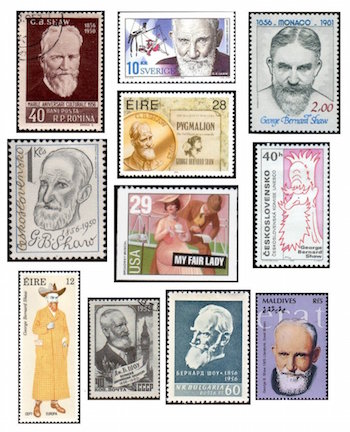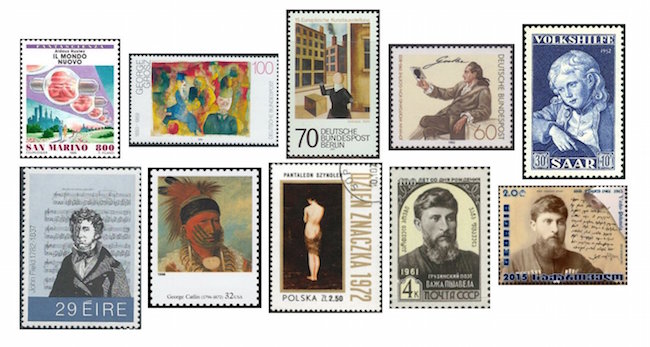The Arts on Stamps of the World — July 26
An Arts Fuse regular feature: the arts on stamps of the world.

By Doug Briscoe
Another blockbuster day is on hand, with George Bernard Shaw, Aldous Huxley, George Grosz, Stanley Kubrick, Helen Mirren, Mick Jagger, Gracie Allen, and Vivian Vance leading the pack, followed by a host of others!

Besides his well known work as a playwright and polemicist, George Bernard Shaw (26 July 1856 – 2 November 1950) wrote extensively about music throughout his life, particularly in the 1880s and ’90s, occasionally offering up an unexpected opinion, such as that the symphony by Hermann Goetz was better than any by Brahms, Schumann, or Mendelssohn. By the way, Oscar Straus’s operetta The Chocolate Soldier (1908) is based on Arms and the Man, and, of course, there’s the musical My Fair Lady after Pygmalion. Music for a 1938 film of that name was composed by Honegger, and other films of Shaw’s plays were scored by Walton, Auric, and Richard Rodney Bennett.
Aldous Huxley (26 July 1894 – 22 November 1963) has not been so blessed—if that’s the word for it—on the world’s postage stamps. Indeed, the only one I could find comes from an Italian set devoted to films of science fiction novels. It cites Ettore Scola’s 1982 dramatization of Brave New World, Il mondo nuovo. Huxley and C.S. Lewis both died on the day of the John F. Kennedy assassination, and both great writers ended up being Page 6 news. Now, because we have so many people to see today, Huxley is getting snubbed again.
German artist George Grosz (1893 – July 6, 1959) was best known for the satirical drawings he made depicting Berlin city life in the 1920s, but after coming to the U.S. he gave up caricature. He was born Georg Groß in Berlin, but in the midst of World War I he altered the spelling to make the name less specifically German and more international. (His friend the painter Helmut Herzfeld similarly changed his name to John Heartfield.) Grosz was prosecuted for “insulting the army” (see his 1920 drawing “Made in Germany” for an example) and for blasphemy in his work. A member of the German Communist Party from 1918, he traveled to Moscow with Martin Andersen Nexø in 1922 and was left so disillusioned that he abandoned the party the next year. Another political entity he had little use for was the NSDAP, and he and his family left Germany eighteen days before Hitler entered office. He became a teacher in the United States—among his students was Romare Bearden—and adopted citizenship in 1938. As stated above, he renounced his earlier style and turned to paintings of nudes and landscapes. His son Marty Grosz is a jazz guitarist. The stamps show his colored drawing Café (1918-19) and an Untitled painting from 1920.
For our next subject, another German painter, we revert to the eighteenth century. Georg Melchior Kraus (26 July 1737, in Frankfurt am Main – 5 November 1806, in Weimar) studied with Tischbein and was a friend of Goethe, of whom he made the portrait seen on the first stamp. The stamp from the Saar displays his Portrait of a Boy (undated).

Irish composer and pianist John Field is thought to have been born on July 26, 1782, though he was not baptized until September 5. He is known for having written nocturnes for solo piano before Chopin had the idea. While Field was still a child, his family moved from his native Dublin to London, where he studied with Muzio Clementi. His life thereafter was one of unbroken artistic and commercial success. He and Clementi toured together on the continent. In Vienna, Field took some lessons with Beethoven’s teacher Albrechtsberger. He ended up in Russia and remained there for most of the rest of his life, wealthy enough to be able to decline a proffered post as court pianist at St. Petersburg. In 1831 he returned to London, but only for the purpose of seeking medical attention for his cancer. He remained in the country for a few years, his health declining, before making his way back to Russia, where he died from pneumonia on 23 January 1837.
The American painter George Catlin (1796 – December 23, 1872) documented Native Americans in hundreds of portraits, one of which is White Cloud, Head Chief of the Iowas (1840s). Fascinated with Indian lore from his Pennsylvania childhood, he was spurred to go west when he saw some of the artifacts brought back by the Lewis and Clark expedition. In 1830 he became the first white man to paint Native Americans in their own environment. In 1841 Catlin published the first of his books, Manners, Customs, and Condition of the North American Indians, which contained some 300 engravings.
Born fifty years later to the day was another painter, Pantaleon Szyndler (or Szendler, 26 July 1846 – 31 January 1905), a Pole who studied in Warsaw, Munich, Paris, and Rome. On the stamp we see one of his many nudes, Bathing Girl (1885).
The Georgian poet known as Vazha-Pshavela, or just Vazha (1861 – 10 July 1915) was born Luka Razikashvili in a remote village and went to a seminary before studying law. Besides his hundreds of poems focusing on life and customs of the Pshavi region, there are also plays and stories in the same vein. He is held by many to be the foremost master of Georgian literature and is honored on two stamps, an old one from the Soviet Union (1961) and a Georgian one issued just two years ago.
Collage No. 3 begins with a return to the visual arts and Danish painter and illustrator Fritz Syberg (1862 – 20 December 1939), one of the three most prominent members of the “Funen Painters” group (the others being Peter Hansen and Johannes Larsen. Apart from his paintings, such as The Hill at Overkærby (1917) on a Danish stamp of 1987, he created a set of eighteen large drawings for an edition of Hans Christian Andersen’s The Story of a Mother. A sample of that work can be see here.

Latvian composer Jāzeps Vītols (26 July 1863 – 24 April 1948) studied with Rimsky-Korsakov at the Saint Petersburg Conservatory and remained there to teach, one of his students being Prokofiev. When Latvia achieved independence after World War I, Vītols returned to direct the Latvian National Opera and to found the Latvian Conservatory of Music, later renamed for him, from 1919 to 1944, when he moved to Lübeck for the last four years of his life. He wrote one work each in the genre of symphony, string quartet, and piano sonata, with much choral music. Given his time in Germany, his name is sometimes rendered as Joseph Wihtol.
July 26 is also the natal day of Spanish poet Antonio Machado (1875 – 22 February 1939). He and his brother Manuel were both members of the group dubbed the Generation of ’98. Their meeting in Paris with such lights of literature as Verlaine and Oscar Wilde committed Antonio to a life in poetry, his first poems seeing publication in 1901. He was devastated by the loss of his young wife to tuberculosis, a tragedy that had an effect on his subsequent writing, which became less ornate. He rejoined his brother to collaborate on plays. The Spanish Civil War separated them permanently; Antonio escaped with their mother to France, but both died there shortly after their arrival. Machado’s poems have been set to music by Rodrigo, Pedrell, Dallapiccola, and others.
Remarkably, we have four actresses who share this July 26 birthday! Two of them show up in the same large sheet of Early TV Memories issued by the USPS in 2009. In order of their birth, they are George Burns’s wife and comedy partner Gracie Allen (1895 – August 27, 1964), I Love Lucy co-star Vivian Vance (1909 – August 17, 1979), the splendid Dame Helen Mirren (née Mironoff; born 26 July 1945), seen on a Guinea-Bissau stamp as Cleopatra opposite Alan Rickman’s Antony, and Nana Visitor (born Nana Tucker; July 26, 1957), who played Kira Nerys in Star Trek: Deep Space Nine. Her stamps come from DS9 sheets issued by Tanzania and Guyana.
The last of today’s six (!) painters is Christian Caillard (1899 – September 1985). After artillery service in the final year of World War I, he gave up his science studies and turned to art. Encouraged by his visit to Morocco in 1927, he broadened his travels to Indochina, Bali, Tahiti, and Martinique. Though continuing to travel all over the world, Caillard lived at the same address in Paris for fifty years, from 1935 till his death. The stamp, from Cambodia, shows his Young Harlequin With Violin.
Maltese tenor Oreste Kirkop (1923 – 10 May 1998) went to Britain in 1950, subsequently performing with Sadler’s Wells and at Covent Garden. He moved on to Hollywood and appeared in the title role of the 1956 film The Vagabond King. He also appeared in the first televised productions (on NBC) of Madame Butterfly, La traviata, and Rigoletto. As the result of a heart ailment, he retired from singing at the age of 37. He died in his native Malta 38 years later, on May 10, 1998.
I expect it’s only a matter of time before Stanley Kubrick (July 26, 1928 – March 7, 1999) himself is recognized on a stamp, but for now we must make do with a still from 2001: A Space Odyssey, taken from a set of British stamps looking back on the country’s film industry.
Mick Jagger (Sir Michael Philip Jagger, if you please, born 26 July 1943) doesn’t have to wait. He is already found on stamps from Austria and Tanzania, among others.
Today is also the 135th anniversary of the première of Wagner’s last opera Parsifal, given at the Bayreuth Festspielhaus on 26 July 1882 under Hermann Levi. The stamp, the only one in existence as far as I know, is one of the 1933 Wagner set of stamps that was the first to be issued under the Third Reich.
Disney’s Alice in Wonderland also had its first showing on this date in 1951 (in London), and it so happens that a set of Disney stamps, featuring villains from eight movies, just came out this month, so I can pay tribute with the cartoon Queen of Hearts.
And happy birthday to one of my favorite actors, Kevin Spacey (born July 26, 1959).
A graduate of the University of Massachusetts with a B.A. in English, Doug Briscoe worked in Boston classical music radio, at WCRB, WGBH, and WBUR, for about 25 years, beginning in 1977. He has the curious distinction of having succeeded Robert J. Lurtsema twice, first as host of WGBH’s weekday morning classical music program in 1993, then as host of the weekend program when Robert J.’s health failed in 2000. Doug also wrote liner notes for several of the late Gunther Schuller’s GM Recordings releases as well as program notes for the Boston Classical Orchestra. For the past few years he’s been posting a Facebook “blog” of classical music on stamps of the world, which has now been expanded to encompass all the arts for The Arts Fuse.
